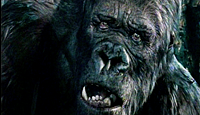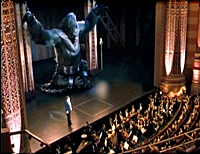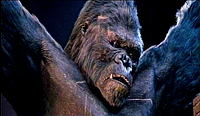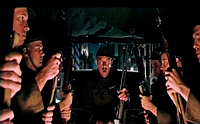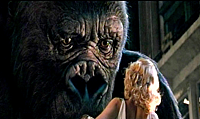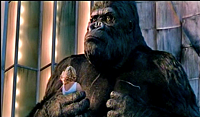The Passion of the Kong
How to Turn a Classic into a Masterpiece
An Appreciation by Barry M. Lamont
Suffering
The passion play, though it runs throughout the fourth section of the film (back in New York City), actually begins at the end of the third section (Skull Island) with the capture of Kong - the one scene whose brutality approaches Gibson's film, yet it comes across as more poignant, because of the context which Jackson has provided, and because of Ann. Matthew gives a rather dry account of Jesus' betrayal by Judas - and of course, he knew it was coming, and was resigned to it. By contrast, when Kong understands Ann's betrayal, his reaction - his body language, the expression on his face - conveys the emotion of that scene with a power which the printed word can not match. (You will notice that there are several reaction shots of Naomi Watts, and almost none of anybody else. This is because, when they filmed this sequence, everyone on the set was in tears, but that wasn't really appropriate for anyone else's character.)
[ Matthew 27:28-29 : They stripped him, and put on him a scarlet robe. And when they had plaited a crown of thorns, they put it upon his head, and a reed in his right hand: and they bowed the knee before him, and mocked him, saying, Hail, King of the Jews!]
Back in New York, when the "savage beast" is first unveiled in the Alhambra Theater, the audience gasps, then applauds. We can see what they fail to see: Kong is in a state of the most abject misery. Denham, as if it were an act of remarkable courage, declares, "I am touching the beast"; Kong listlessly shrugs, Denham jumps back, and the audience laughs. To re-assert his dominance, Denham orders the chains on Kong's arms to be raised; his intention is to create an image of power and menace, but the result is an unmistakable posture of crucifixion. Again, the audience applauds; oblivious to the truth before them, they are entertained by his suffering.
[Matthew 27:42 : If he be the King of Israel, let him now come down from the cross, and we will believe him.]
King Kong eventually breaks his chains, of course, and goes tearing through the city. The scene, even though it is mainly an action sequence, is much more fully realized than in 1933. Jack Driscoll re-enters the story in a way which continues his own personal growth, plausibly allows him to play the hero, and sets up the ending of the film. In a slightly later scene, we get one of the rare humorous touches in the second half of the film, as Peter Jackson succinctly disposes of a certain kind of jingoistic patriotism. What is most noteworthy, however, is that in the 1933 film we may be able to understand Kong's plight, but his blind, unpredictable destructiveness keeps us at arm's length; in 2005, we feel his desperation, his very focused anger, and we are with him all the way.
When Kong reunites with Ann - and you can see the wariness in his posture, and the hurt in his eyes - they share one final moment of childlike joy, in a scene in Central Park at Christmastime which shouldn't work, but does. This scene, added during filming and not present in the 1933 version, provides a brief and welcome respite from the action, a gentle moment which heightens the effect of what follows. When the world comes crashing in on them, Kong takes Ann up to the Empire State Building - the closest thing he can find to his sanctuary on Skull Island, but also his Golgotha. Together, quietly, they watch the sun rise for the last time.
[Christ in Gethsemane, Matthew 26:38,40 : Then saith he unto them, My soul is exceeding sorrowful, even unto death: tarry ye here, and watch with me . . . And he cometh unto the disciples, and findeth them asleep, and saith unto Peter, What, could ye not watch with me one hour?]
[ Matthew 27:28-29 : They stripped him, and put on him a scarlet robe. And when they had plaited a crown of thorns, they put it upon his head, and a reed in his right hand: and they bowed the knee before him, and mocked him, saying, Hail, King of the Jews!]
Back in New York, when the "savage beast" is first unveiled in the Alhambra Theater, the audience gasps, then applauds. We can see what they fail to see: Kong is in a state of the most abject misery. Denham, as if it were an act of remarkable courage, declares, "I am touching the beast"; Kong listlessly shrugs, Denham jumps back, and the audience laughs. To re-assert his dominance, Denham orders the chains on Kong's arms to be raised; his intention is to create an image of power and menace, but the result is an unmistakable posture of crucifixion. Again, the audience applauds; oblivious to the truth before them, they are entertained by his suffering.
[Matthew 27:42 : If he be the King of Israel, let him now come down from the cross, and we will believe him.]
King Kong eventually breaks his chains, of course, and goes tearing through the city. The scene, even though it is mainly an action sequence, is much more fully realized than in 1933. Jack Driscoll re-enters the story in a way which continues his own personal growth, plausibly allows him to play the hero, and sets up the ending of the film. In a slightly later scene, we get one of the rare humorous touches in the second half of the film, as Peter Jackson succinctly disposes of a certain kind of jingoistic patriotism. What is most noteworthy, however, is that in the 1933 film we may be able to understand Kong's plight, but his blind, unpredictable destructiveness keeps us at arm's length; in 2005, we feel his desperation, his very focused anger, and we are with him all the way.
When Kong reunites with Ann - and you can see the wariness in his posture, and the hurt in his eyes - they share one final moment of childlike joy, in a scene in Central Park at Christmastime which shouldn't work, but does. This scene, added during filming and not present in the 1933 version, provides a brief and welcome respite from the action, a gentle moment which heightens the effect of what follows. When the world comes crashing in on them, Kong takes Ann up to the Empire State Building - the closest thing he can find to his sanctuary on Skull Island, but also his Golgotha. Together, quietly, they watch the sun rise for the last time.
[Christ in Gethsemane, Matthew 26:38,40 : Then saith he unto them, My soul is exceeding sorrowful, even unto death: tarry ye here, and watch with me . . . And he cometh unto the disciples, and findeth them asleep, and saith unto Peter, What, could ye not watch with me one hour?]
